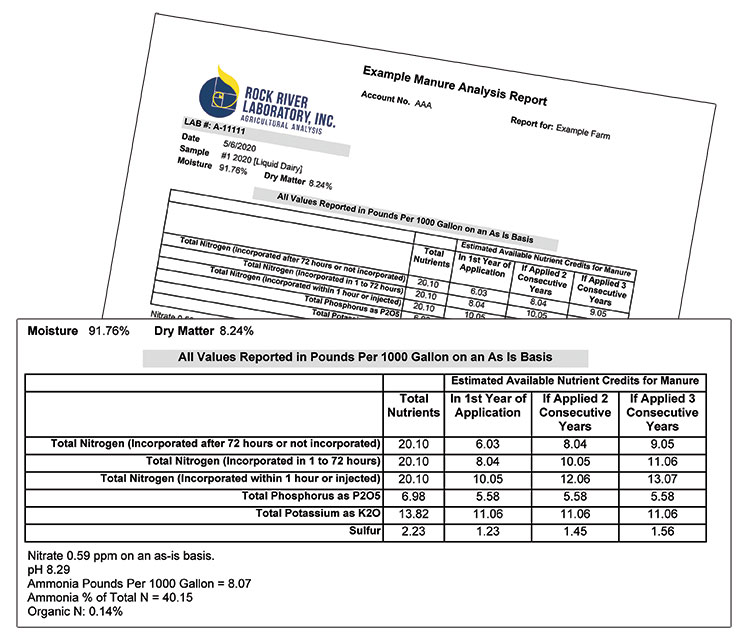
At times, interpreting manure analysis reports may seem to practically require a doctorate degree. Confusing is just the tip of the iceberg of obstacles one might face when navigating through the ocean of information. As a Certified Crop Advisor (CCA), I have seen numerous reports from various laboratories, and even I may become disoriented when reading a manure analysis. Much of this confusion stems from the diverse report formats across laboratories. Terminology also challenges the reader as it differs across reports, even though it discloses the same information.
One valuable approach for interpreting a manure analysis report is to break it down into individual components. When we look at each part of the report on its own, the whole becomes a lot more manageable.
The most important analytes
All manure reports will include the following basic analytes in some format. Depending on the analysis package, additional elements may be included. Typical add-ons are micronutrients such as manganese, zinc, and boron.
Moisture: This component determines how manure will be handled and how it will behave in the environment. It also dictates if results will be given in nutrients per ton or nutrients per 1,000 gallons.
Nitrogen (N): This nutrient is a key contributor to plant growth, and it is especially important early in the growing season. Nitrogen content can be difficult to determine because it is expressed in many ways. Manure also contains multiple forms of nitrogen such as organic, inorganic, and total Kjeldahl nitrogen (TKN). The number to focus on is total nitrogen, remembering that not all nitrogen is available the first year it is applied.
The nitrogen content of manure will also vary by application method. Manure that is injected, incorporated, or surface applied will have different forms of nitrogen available for the crop. This is due to volatilization that takes place when the nitrogen sits on the soil surface.
Phosphorus (P): The phosphorus within the proverbial “NPK” group provides energy for the plant by aiding in photosynthesis. Phosphorus also plays a key role in root development and reproduction.
Potassium (K): This element assists water movement in the plant and helps create strong stalks and stems.
Sulfur (S): This is often the forgotten nutrient. Sulfur almost made the list of primary macronutrients when they were first discovered.
Sulfur aids in nodule development, nitrogen fixation, and improved winter hardiness in legumes. It is also believed to play a role in nutrient density.
Prioritize the nutrients
Nutrients are applied to crops for different reasons. If the goal is to meet a grass crop’s needs, nitrogen is the most important analyte in a manure analysis. Depending on manure application rules, the manure can then be applied at a rate to meet the nitrogen demand.
When applying manure as a nitrogen source to a grass crop, you should also review the sulfur content of the manure. While sulfur additions were not necessary several decades ago, it is now a vital nutrient addition due to reduced atmospheric deposition. While the manure is not applied to meet the crop’s sulfur demand, the sulfur in the manure should still be credited against the crop’s sulfur demand.
Applying manure based on a phosphorus management strategy is becoming more prevalent — as opposed to doing so in order to meet crop demands. The phosphorus management methods vary from state to state, but they all rely on knowing crop removal and applying the same or less than crop removal.
Another strategy for manure application is to look at the analysis and determine where that manure would fit best within the system. For instance, if the manure contains high volumes of nitrogen but low volumes of phosphorus, it would fit well on a grass crop. If the manure is low in nitrogen, it may be a good fit for topdressing alfalfa fields. If the manure is high in phosphorus content, it is best applied on fields with a low soil test phosphorus result.
What is it worth?
Placing a value on manure can be even more difficult than interpreting the analysis report. The simplest method places value on only the nitrogen component. To establish a value based on nitrogen, a “nitrogen cost” is required.
The easiest means is to determine the cost of 1 unit of commercial nitrogen, then multiply the commercial nitrogen price by the nitrogen content of the manure. This will give you the value per 1,000 gallons or per 1 ton of manure. Remember, nutrients per unit is determined by the moisture content of the manure.
You could also value the manure based on its total macronutrient content. This method is similar to valuing it based on nitrogen, but it would include nitrogen, phosphorus, and potassium. If using this method, you could also include the sulfur content of the manure.
This method of valuing manure could also include all of the nutrients available for analysis. While incorporating those additions is probably a bit extreme and definitely time consuming, all of the nutrients in manure carry value.
Reviewing and digesting a manure report can be tricky, but if you break the report down into its individual components, it becomes more manageable. Review each piece of the report on its own and consider its contribution to the manure’s benefits before taking on the icy waters of the entire report. The decision-making process can then move on to prioritizing decision making based on each analyte. This will, in turn, help determine where and how to best utilize the manure to achieve maximum value. Navigating manure analysis reports can prove overwhelming at the start, but achieving familiarity with the individual components will help avoid a Titanic-sized mistake.
This article appeared in the February 2021 issue of Management on pages 18 and 19.
Not a subscriber? Click to get the print magazine.










